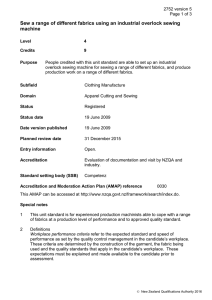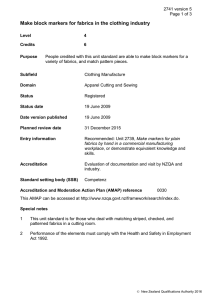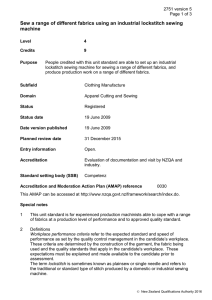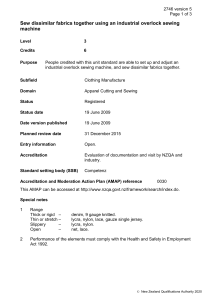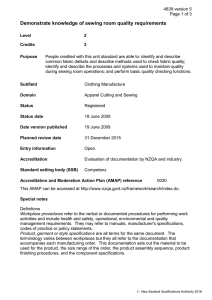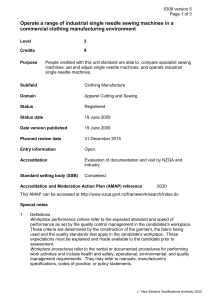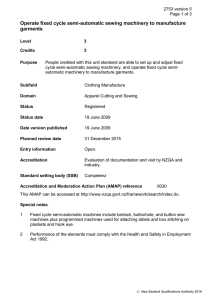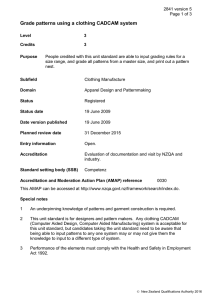Sew different fabrics using an industrial walking foot sewing machine... a commercial clothing manufacturing workplace
advertisement
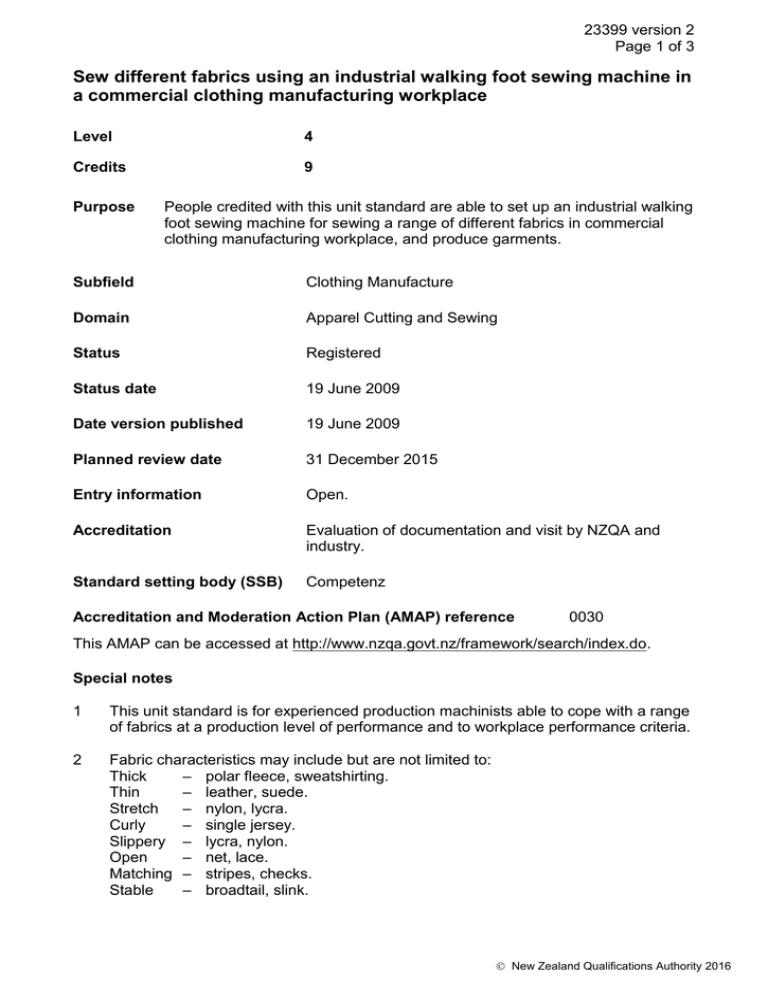
23399 version 2 Page 1 of 3 Sew different fabrics using an industrial walking foot sewing machine in a commercial clothing manufacturing workplace Level 4 Credits 9 Purpose People credited with this unit standard are able to set up an industrial walking foot sewing machine for sewing a range of different fabrics in commercial clothing manufacturing workplace, and produce garments. Subfield Clothing Manufacture Domain Apparel Cutting and Sewing Status Registered Status date 19 June 2009 Date version published 19 June 2009 Planned review date 31 December 2015 Entry information Open. Accreditation Evaluation of documentation and visit by NZQA and industry. Standard setting body (SSB) Competenz Accreditation and Moderation Action Plan (AMAP) reference 0030 This AMAP can be accessed at http://www.nzqa.govt.nz/framework/search/index.do. Special notes 1 This unit standard is for experienced production machinists able to cope with a range of fabrics at a production level of performance and to workplace performance criteria. 2 Fabric characteristics may include but are not limited to: Thick – polar fleece, sweatshirting. Thin – leather, suede. Stretch – nylon, lycra. Curly – single jersey. Slippery – lycra, nylon. Open – net, lace. Matching – stripes, checks. Stable – broadtail, slink. New Zealand Qualifications Authority 2016 23399 version 2 Page 2 of 3 3 Performance of the elements must comply with the Health and Safety in Employment Act 1992. 4 Definitions Workplace performance criteria refer to the expected standard and speed of performance as set by the quality control management in the candidate’s workplace. These criteria are determined by the construction of the garment, the fabric being used and the quality standards that apply in the candidate’s workplace. These expectations must be explained and made available to the candidate prior to assessment. Product, style or garment specifications refer to the documentation that accompanies each manufacturing order. This documentation sets out the fabric to be used for the product, the size range of the order, the product assembly sequence, product finishing procedures, and the product component specifications. Elements and performance criteria Element 1 Set up an industrial walking foot sewing machine for sewing a range of different fabrics in a commercial clothing manufacturing workplace. Range fabrics – any four. Performance criteria 1.1 Thread selection is compatible with the fabrics to be sewn. Range decorative, strength, twist, composition. 1.2 Top and bottom stitches are compatible with product specifications. 1.3 Needle size and feed dogs selected are compatible with fabrics to be sewn. 1.4 Machine foot is selected to fit operation and fabric requirements. 1.5 Quality of stitch is tested and checked according to workplace performance criteria. 1.6 Stitch density meets product specifications. Element 2 Produce garments in a range of different fabrics. Range fabrics – any four. Performance criteria 2.1 Work is completed to product specifications and workplace performance criteria. New Zealand Qualifications Authority 2016 23399 version 2 Page 3 of 3 2.2 Work practice meets workplace performance criteria and procedures. 2.3 Documentation is completed in accordance with workplace procedures. Please note Providers must be accredited by NZQA, or an inter-institutional body with delegated authority for quality assurance, before they can report credits from assessment against unit standards or deliver courses of study leading to that assessment. Industry Training Organisations must be accredited by NZQA before they can register credits from assessment against unit standards. Accredited providers and Industry Training Organisations assessing against unit standards must engage with the moderation system that applies to those standards. Accreditation requirements and an outline of the moderation system that applies to this standard are outlined in the Accreditation and Moderation Action Plan (AMAP). The AMAP also includes useful information about special requirements for organisations wishing to develop education and training programmes, such as minimum qualifications for tutors and assessors, and special resource requirements. Comments on this unit standard Please contact Competenz info@competenz.org.nz if you wish to suggest changes to the content of this unit standard. New Zealand Qualifications Authority 2016
